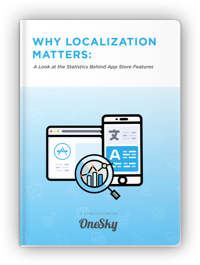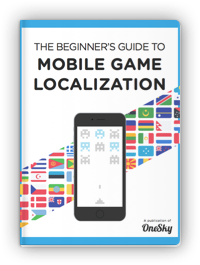Multi Agent Systems: Unlocking New Potentials for Modern Businesses
Artificial intelligence is redefining industries, and multi-agent systems (MAS) are at the forefront of this transformation.
Unlike single-agent systems, MAS harnesses the collective power of multiple independent AI agents, each contributing unique skills to tackle complex challenges.
By collaborating, these agents drive efficiency and innovation, positioning businesses for greater success.
So, how exactly do multi-agent systems enhance business operations?
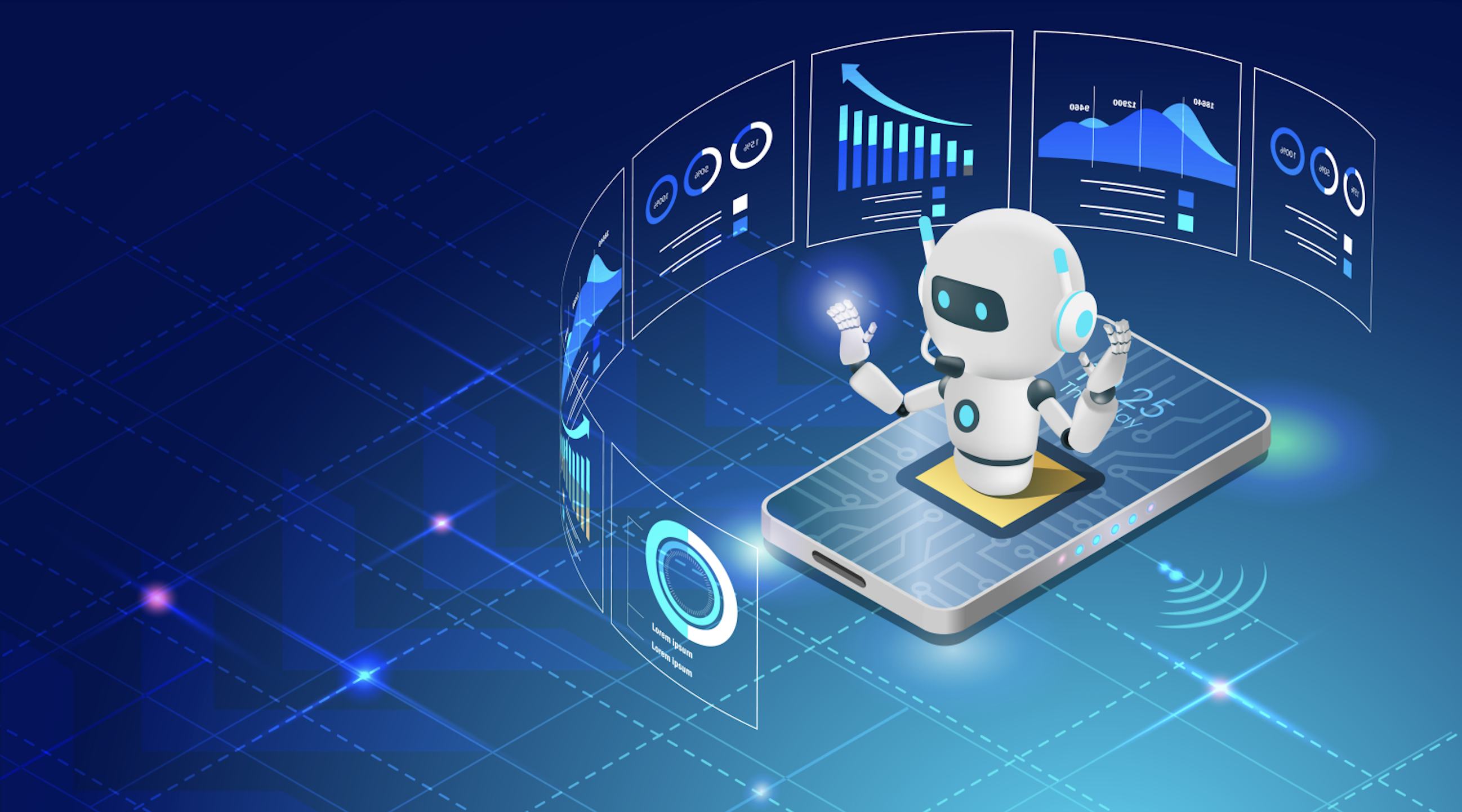
What Are Multi Agent Systems?
Definition and Overview
Multi-agent systems are frameworks where several autonomous AI agents work together to accomplish complex tasks.
Each of these agents operates independently but collaborates with others to achieve a common objective, making them essential for solving intricate, large-scale problems.
Key Characteristics
- Autonomy: Each agent independently makes decisions based on real-time inputs.
- Collaboration: Agents work together, sharing information and coordinating actions to reach shared goals.
- Scalability: By distributing tasks across multiple agents, MAS improve efficiency in handling large and complex environments.
Multi-agent systems utilize advanced technologies like large language models (LLMs) for processing and responding to user inputs.
They synergize distinct capabilities from each agent, leading to solutions that single-agent systems might find challenging to implement.
These systems dynamically adapt to changes, mirroring the adaptive nature of human teams but at a scale and speed unattainable by human effort alone.
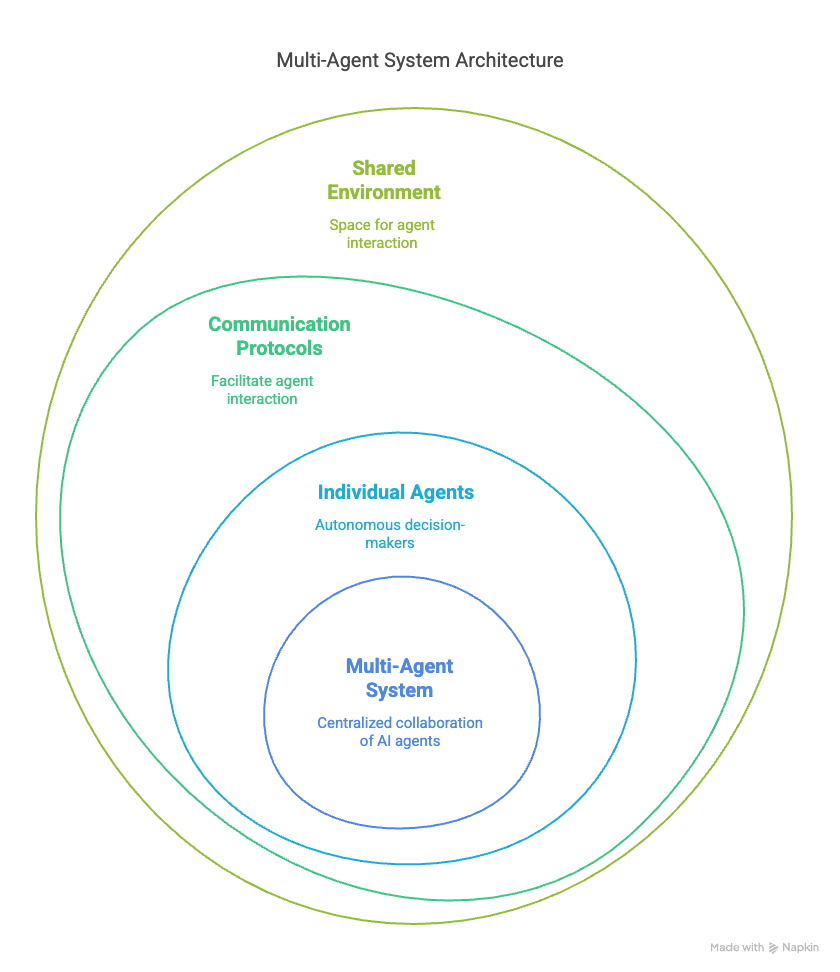
Core Components and Architecture of Multi Agent Systems
Unlocking the Power of Collaboration in AI
A multi-agent system (MAS) involves multiple AI-driven agents working together to solve complex problems.
Think of each agent as a specialist—handling a specific task or domain—yet all collaborating seamlessly to achieve a broader goal.
Instead of relying on one monolithic system, MAS distributes intelligence, making solutions smarter, faster, and more flexible.
Key Components
1. An Individual Agent
Each AI agent operates autonomously, with its own decision-making ability.
It specializes in tasks like data analysis, language understanding, or tool invocation, and acts independently within the system.
2. Communication Protocols
How do these agents talk?
They exchange messages, data, and instructions consistently—either directly (peer-to-peer) or through a central controller.
Communication frameworks ensure coordination and prevent chaos.
3. Shared Environment
The environment is the digital or physical space where agents interact—be it a cloud platform, a virtual workspace, or real-time data streams.
This shared space is critical for synchronization and cooperation.
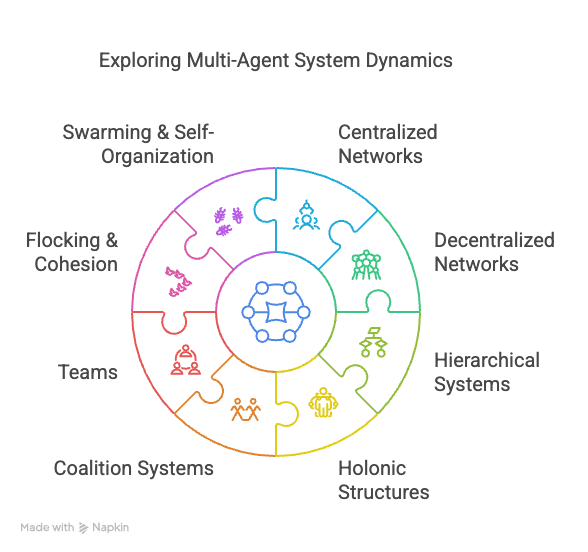
How Multi Agent Systems Operate: Architecture & Behaviors Unveiled
Architecture of Multi Agent Systems: Building the Framework for Collaboration
A multi-agent system (MAS) isn’t just a collection of autonomous agents—it’s a carefully crafted network designed to solve intricate problems more efficiently than any single AI could.
The architecture defines how agents communicate, collaborate, and function within the system.
1. Centralized Networks
Think of a conductor leading an orchestra.
In a centralized MAS, one main controller holds all knowledge and directs every agent’s activity. This makes communication simple—agents operate with a shared, uniform understanding.
However, this setup bears a major risk: if the conductor fails, the entire system can come to a halt.
2. Decentralized Networks
Here, agents talk directly with one another—like a community of experts sharing knowledge without a single boss.
This makes the system more robust, scalable, and adaptable.
The challenge? Ensuring coordination and consistency across independent agents becomes more complex.
Organizational Structures: Tailoring MAS to Business Needs
3. Hierarchical Systems
Picture a tree: a top-level agent sets goals and assigns tasks to subordinate agents.
This layered approach supports clear decision chains and task delegation—perfect for organizations needing structured workflows.
4. Holonic Structures
Inspired by biological systems, holonic MAS organize agents into self-contained units (holons).
Think of these as body organs working together—some holons can be nested within others, providing flexibility, scalability, and resilience.
This structure is self-organized, with each holon contributing to overarching goals.
5. Coalition Systems
When individual agents underperform, they band together temporarily, forming a coalition to boost their collective effectiveness.
Once the goal is met, the coalition disbands.
This flexible collaboration is ideal for dynamic environments where tasks are unpredictable and performance is critical.
6. Teams
More tightly integrated than coalitions, teams consist of agents working closely toward shared objectives.
Their hierarchical nature allows deep cooperation—and the ability to handle complex, interdependent tasks with greater efficiency.
System Behaviors & Dynamics: Mimicking Nature for Smarter Operations
7. Flocking & Cohesion
Inspired by bird flocks and fish schools, agents share an objective and coordinate movements using simple heuristics:
- Separation: Avoid collisions
- Alignment: Match velocities with neighbors
- Cohesion: Stay close to the group
This behavior ensures organized, collective movement—crucial in traffic management, transportation networks, and robotics.
8. Swarming & Self-Organization
Agents can spontaneously organize into groups, much like insects or birds, without central control.
Swarming allows a large number of agents to accomplish tasks collectively and reliably, even in challenging environments.
This decentralized approach makes training and managing large fleets more efficient and less resource-intensive.
Why Designing the Right Architecture Matters?
Choosing the right architecture depends on your system’s goals.
Centralized models are simple but fragile; decentralized systems are robust but complex to coordinate.
Hierarchies and holons support structured, scalable operations, while coalitions and teams foster flexible, problem-specific collaboration.
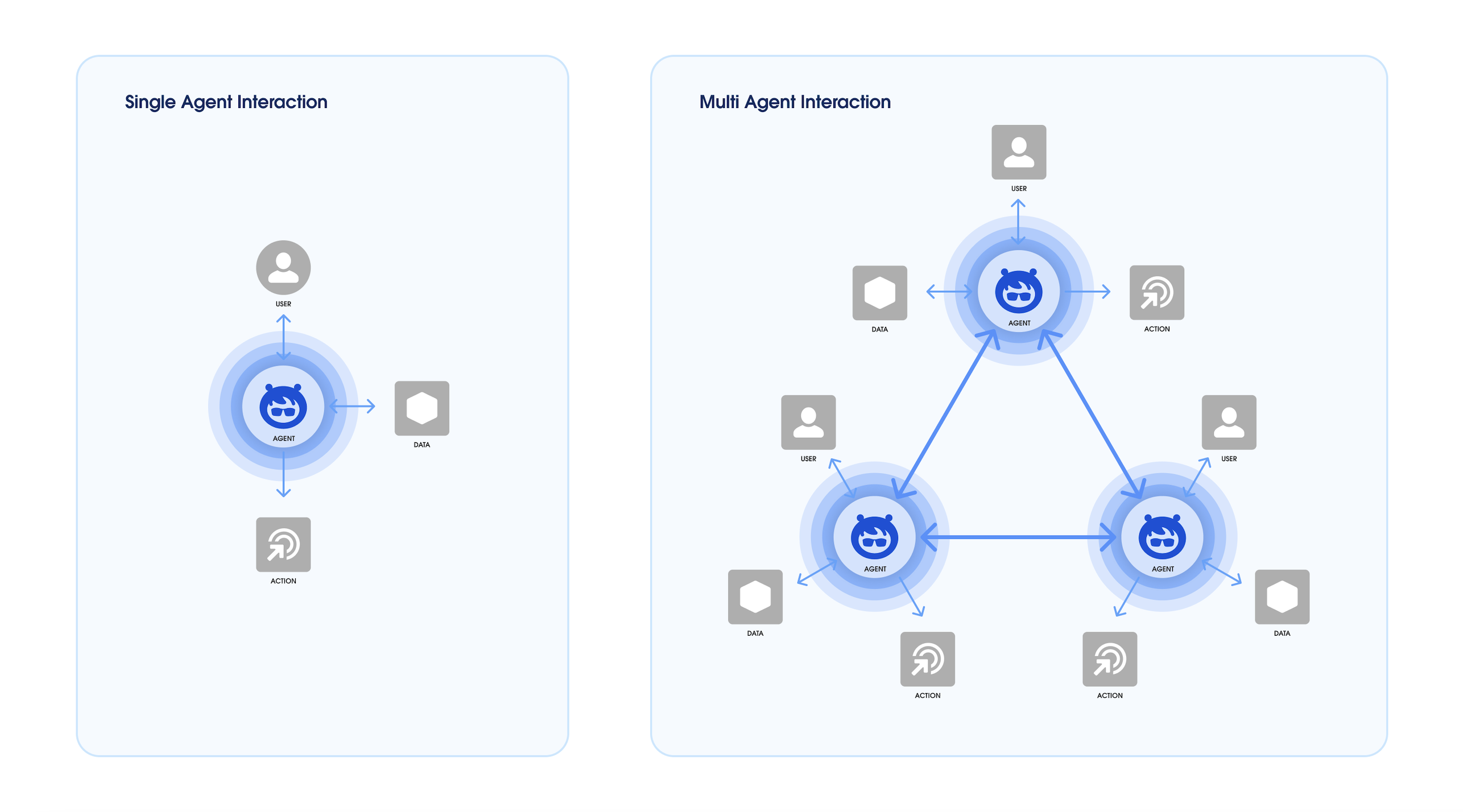
Single-Agent vs. Multi-Agent Systems: Understanding the Key Differences
Single-Agent Systems: Focused and Simple
A single-agent system revolves around one autonomous AI entity managing tasks independently.
Think of tools like Siri or Alexa — powerful within their scope, but designed for straightforward interactions in controlled environments.
These systems excel at direct, well-defined tasks such as scheduling, information retrieval, or basic automation.
They operate without needing to coordinate with others, making them ideal for predictable, low-complexity use cases.
Multi-Agent Systems: Collaboration for Complexity
Multi-agent systems (MAS), on the other hand, are collections of multiple AI agents working together—a digital team with diverse specializations.
Each agent has its own role, skillset, and decision-making autonomy.
Their true strength lies in collaboration, sharing information, and orchestrating complex workflows much like a skilled project team.
How do they differ?
1. Coordination and Communication
MAS involves dynamic, often bidirectional communication between agents—either directly or through shared environments—enabling real-time collaboration.
Single agents operate in isolation, with no need for other entities.
2. Specialization
In MAS, each agent can be optimized for specific tasks—think of a dedicated agent for scheduling, another for analytics, and another for customer support—improving overall system efficiency.
3. Scalability & Complexity
Multi-agent systems scale effortlessly.
They handle large, multi-step problems—such as logistics, supply chain management, or autonomous fleets—by distributing workload and learning from shared experiences.
Why Multi-Agent Systems Outperform Single Agents
- Flexibility & Adaptability: MAS setups adapt quickly to changing environments, combining the strengths of diverse agents solving different facets of a problem.
- Efficiency & Performance: Sharing resources and decentralizing control means more accurate, faster solutions—especially in large-scale operations like manufacturing or cybersecurity.
- Interpretability & Modularity: With multiple agents, it’s easier to identify how each component contributes, troubleshoot, and optimize individual parts for better overall performance.
Key Takeaways
| Single-Agent System | Multi-Agent System |
| Best for predictable, simple tasks | Excels at complex, multi-step problems |
| Operates independently in a controlled environment | Agents collaborate, share info, and adapt in real-time |
| Focused on efficiency within a narrow scope | Distributes workload across specialized agents |
| Easier to develop and deploy but limited scalability | Scales easily, handles large-scale operations |
| Less flexible in dynamic or unpredictable settings | Highly flexible, resilient, and adaptive |
Our Insights
- Single agents are ideal for straightforward, well-defined tasks.
- Multi-agent systems thrive in environments demanding collaboration, specialization, and scalability.
Adopting MAS enables organizations to handle bigger, more complex challenges with greater agility and accuracy, unlocking new levels of operational intelligence.
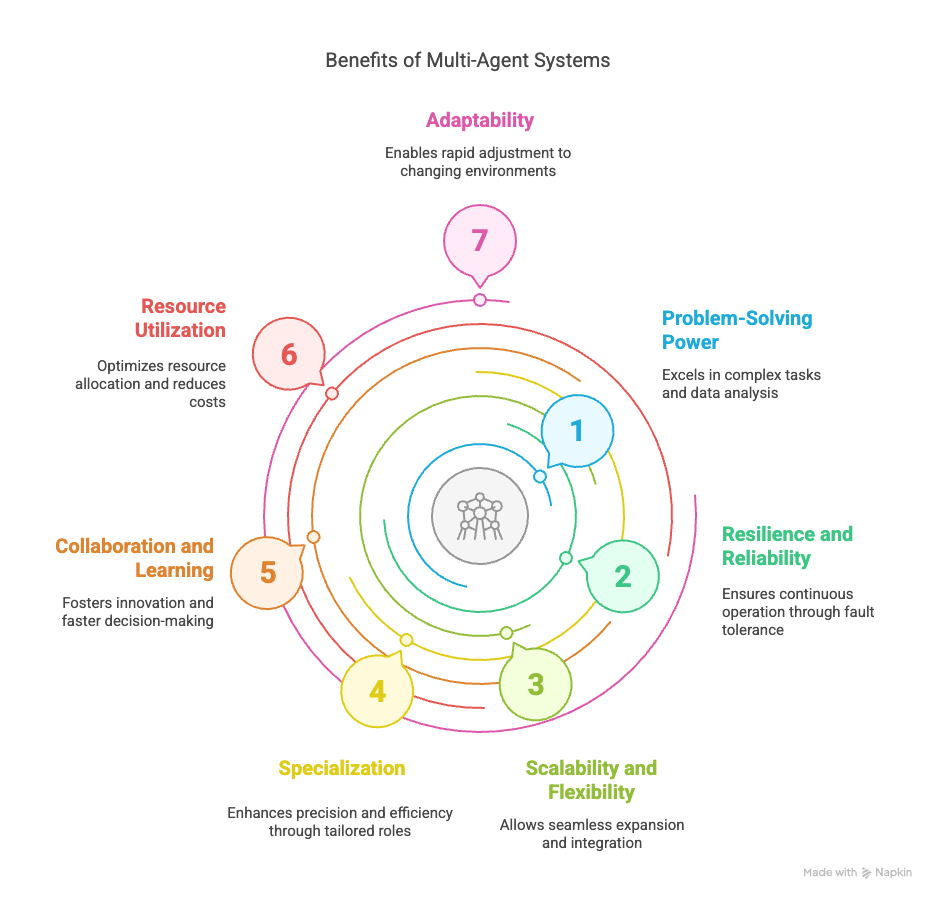
Exploring the Key Benefits of Implementing Multi-Agent Systems
1. Unmatched Problem-Solving Power
Multi-agent systems excel at tackling complex, large-scale problems that are beyond the scope of single AI agents.
By distributing tasks among specialized agents, these systems can analyze vast data sets, coordinate multiple processes, and adapt to changing environments—all in real time.
2. Enhanced Resilience and Reliability
A key strength is fault tolerance.
If one agent encounters an issue or fails, others can take over, ensuring continuous operation.
Think of a fleet of autonomous delivery drones—if one goes offline, the rest recalibrate and keep the system running smoothly.
3. Scalability and Flexibility
Scaling is seamless: add more agents as your business grows or needs evolve.
This modular approach means you don’t have to rebuild from scratch.
Instead, you expand your system’s capabilities by integrating new agents focused on different tasks or domains.
4. Specialization for Precision and Efficiency
Each agent can be fine-tuned for a specific role—whether it’s data analysis, decision-making, or customer engagement.
This specialization boosts accuracy and performance, transforming your AI from a generic tool into a tailored powerhouse.
5. Optimized Collaboration & Learning
Agents communicate, share insights, and learn from each other, much like human teams.
This collaboration results in faster decision-making, more innovative solutions, and continuous improvement—especially valuable in areas like supply chain management, cybersecurity, or autonomous vehicles.
6. Better Resource Utilization & Cost-Effectiveness
By distributing workload across multiple agents, organizations can make better use of resources, avoiding bottlenecks and reducing operational costs.
Automated collaboration also frees up your human team to focus on strategic, high-value tasks.
7. Future-Ready & Adaptive
As markets and environments evolve, so do MAS.
Their decentralized nature enables rapid adaptation to new conditions without overhauling entire systems—making them ideal for industries like finance, healthcare, and manufacturing, where agility is key.
In essence, multi-agent systems are not just a technical evolution—they’re a strategic advantage.
They make organizations smarter, more resilient, and ready to meet the challenges of tomorrow.
Practical Use Cases of Multi Agent Systems
Multi-agent systems are transforming the way organizations address complex, multi-step challenges by distributing responsibilities across specialized AI agents that work collaboratively.
This approach not only automates workflows but also enhances scalability, resilience, and decision-making accuracy.
Here are some of the most impactful areas where MAS is making a difference:
| Industry | Use Case | How MAS Adds Value |
| Transportation & Logistics | Autonomous fleets and traffic management | Agents coordinate vehicle routes, adjust in real time to weather or congestion, and optimize deliveries—reducing delays and costs. Rail systems and ports use MAS to schedule and manage cargo flows, improving throughput. |
| Healthcare & Public Health | Disease tracking and personalized medicine | Multiple agents analyze genetic data, predict outbreaks, and tailor treatments. During epidemics, they simulate spread patterns, allowing better resource allocation and faster responses. |
| Supply Chain & Manufacturing | Inventory optimization and dynamic planning | Agents negotiate, monitor equipment, and optimize resource flows. They predict demand spikes, schedule maintenance, and reroute shipments—helping businesses respond swiftly to market shifts. |
| Security & Defense | Threat detection and simulation | In maritime security, agents simulate attack scenarios and coordinate ship patrols. Cybersecurity MAS monitor networks for anomalies and respond automatically, maintaining organizational security and readiness. |
| Smart Cities & Infrastructure | Traffic control and energy management | Agents synchronize traffic lights based on congestion data, while energy distribution agents balance loads in real time, integrating renewable sources and preventing outages. |
| E-Commerce & Digital Marketplaces | Negotiation and personalized shopping | Agents negotiate prices, manage inventories, and recommend products dynamically based on real-time supply, demand, and customer preferences, creating agile, self-adapting marketplaces. |
Why These Use Cases Matter
- Decentralized Decision-Making: MAS distribute workload, allowing real-time responses in environments like traffic systems or emergency management where centralized control is too slow or fragile.
- Specialization & Precision: With agents tailored for specific roles—be it diagnostics, supply chain negotiation, or threat analysis—they outperform monolithic systems by focusing on expertise.
- Resilience & Scalability: When one agent fails or faces a high load, others seamlessly take over. As the system scales, new agents can be added without disrupting existing workflows.
- Continuous Learning & Adaptation: Agents share insights and experiences, ensuring collective learning that sharpens decision quality in dynamic settings like healthcare or defense.
The Broader Impact
Regardless of industry, multi-agent systems are designed to solve large, complex problems that would overwhelm a single AI or human team.
They enable organizations to operate with higher efficiency, greater reliability, and more agility—traits essential in today’s fast-changing markets.
From managing autonomous fleets to simulating epidemics, MAS is unlocking new levels of operational intelligence, making organizations more responsive, safer, and innovative.
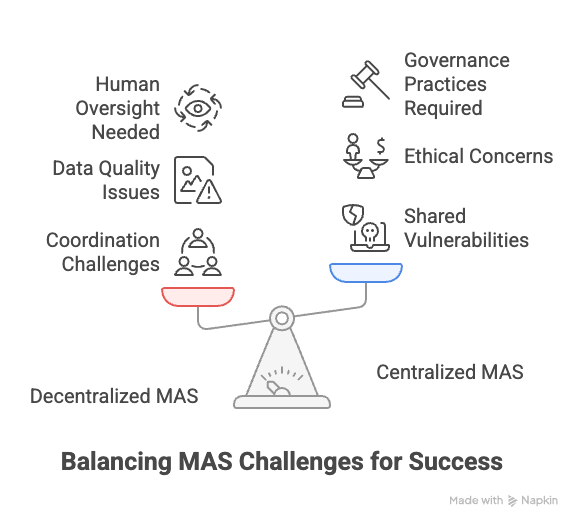
Navigating the Challenges of Multi Agent Systems: What You Need to Know
Implementing a multi-agent system (MAS) offers exciting opportunities—improved scalability, smarter decision-making, and resilient workflows.
But to get the most out of MAS, it’s essential to understand the common hurdles and how to navigate them effectively.
1. Coordinating Agents: Building a Smooth-Running Team
One of the biggest challenges is making sure all agents communicate and work together seamlessly.
Whether through direct messaging, shared environments, or hierarchical controls, clear coordination is key.
If not, agents may step on each other’s toes or waste time duplicating work.
Decentralized MAS are powerful but come with risks.
Shared vulnerabilities—such as weak security or poor data quality—can threaten the entire system.
Carefully designed communication protocols and thorough testing can prevent these issues before they impact your operations.
2. Data & Ethics: Laying a Trustworthy Foundation
MAS depends on data—and not just any data.
High-quality, unbiased data is crucial; poor data can lead to faulty decisions, operational mistakes, or unintentional bias.
Beyond data, maintaining ethical standards is vital.
Protecting user privacy, preventing bias, and ensuring AI decisions align with legal standards build trust with stakeholders.
Strong governance practices and transparency are necessary to keep everything compliant and trustworthy.
3. Human Oversight & Governance: Staying in Control
Despite their autonomy, AI agents still need human oversight, especially during deployment.
Regular monitoring and audits can catch unexpected behaviors, conflicts, or errors early.
It’s also essential to set clear performance metrics for each agent.
Regular reviews keep the system aligned with your goals, flexible enough to adapt as your environment evolves, and secure enough to avoid risks as you scale.
Multi-agent systems offer unmatched potential—more scalability, targeted expertise, and resilience.
But success isn’t automatic. It depends on thoughtful design, strong governance, and ongoing oversight.
By addressing these challenges head-on, you’re building a powerful, dependable ecosystem that can handle even the most complex workflows—transforming how you operate today and preparing you for future growth.
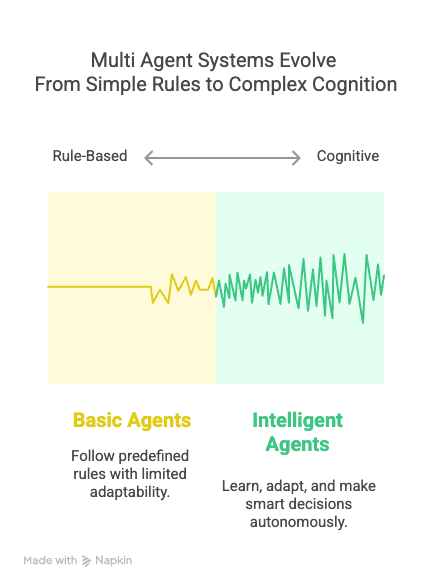
The Future of Multi Agent Systems: Trends and Breakthroughs
The landscape of multi-agent systems (MAS) is evolving fast.
As AI gets smarter, more autonomous, and more integrated, MAS is poised to revolutionize industries, solve complex global challenges, and unlock new levels of operational resilience.
Here’s a look at where the technology is headed—and what you need to know to stay ahead.
Emerging Trends in Multi-Agent Systems
1. Deeper Integration with Advanced Machine Learning
Future MAS will harness cutting-edge AI models, combining natural language understanding, reasoning, and planning.
This means agents won’t just follow predefined rules—they’ll learn, adapt, and make smarter decisions with less human input.
Expect multi-agent systems to analyze vast datasets faster, predict market shifts, or optimize logistics in real time with unparalleled precision.
2. Smarter, More Cognitive Agents
Next-generation agents will boast enhanced cognitive skills, including higher-level reasoning, complex problem-solving, and long-term planning.
They’ll be capable of managing multi-disciplinary tasks—like autonomous robots coordinating in smart cities, or AI-driven healthcare teams designing tailored treatment plans—all without constant oversight.
What This Means for Business and Society
1. Transforming Business Operations
From supply chains to financial markets, MAS will enable organizations to operate more efficiently at a larger scale.
For example, a distributed network of agents could manage energy grids, balancing renewable sources with demand, or coordinate fleets of delivery drones to adapt instantly to weather and traffic conditions.
2. Impacting Society in Big Ways
Imagine smart cities where agents optimize traffic flows, reduce energy waste, and respond to emergencies seamlessly.
Or advanced healthcare systems with agents that collaborate to predict disease outbreaks, personalize treatments, and manage hospital logistics—making healthcare more accessible, efficient, and responsive.
3. Driving AI’s Next Big Leap
Innovations like swarm intelligence—where agents mimic natural collective behaviors—are already gaining traction.
These algorithms improve resource allocation, navigation, and decision-making in unpredictable environments like disaster zones or complex manufacturing lines.
Key Breakthroughs to Watch
- Swarm and Flocking Algorithms: Inspired by nature’s birds and insects, these enable large groups of agents to self-organize, optimize paths, and collaborate efficiently, often with minimal human supervision.
- Distributed Consensus and Formation Control: Recent advances allow agents to synchronize their actions across vast networks, improving robustness against failures or cyberattacks.
- Platform Innovations: Tools like OpenAI’s Swarm Framework or MetaGPT are making MAS development more accessible, scalable, and plug-and-play—empowering developers and organizations to innovate faster.
- Automated Orchestration & Role Assignment: Future systems will automatically assign agents roles, manage interactions, and optimize workflows—all without manual intervention, saving time and reducing errors.
- Enhanced Security & Trust: As MAS become more complex and widespread, building secure communication protocols and transparent decision-making will be critical to prevent misuse or breaches.
The next wave of agentic AI will move beyond automation—forming the backbone of smart infrastructures, autonomous transportation, personalized healthcare, and sustainable energy.
It’s not just an evolution; it’s a revolution.
Companies that adopt and adapt to these innovations will unlock unprecedented agility, resilience, and competitive advantages.
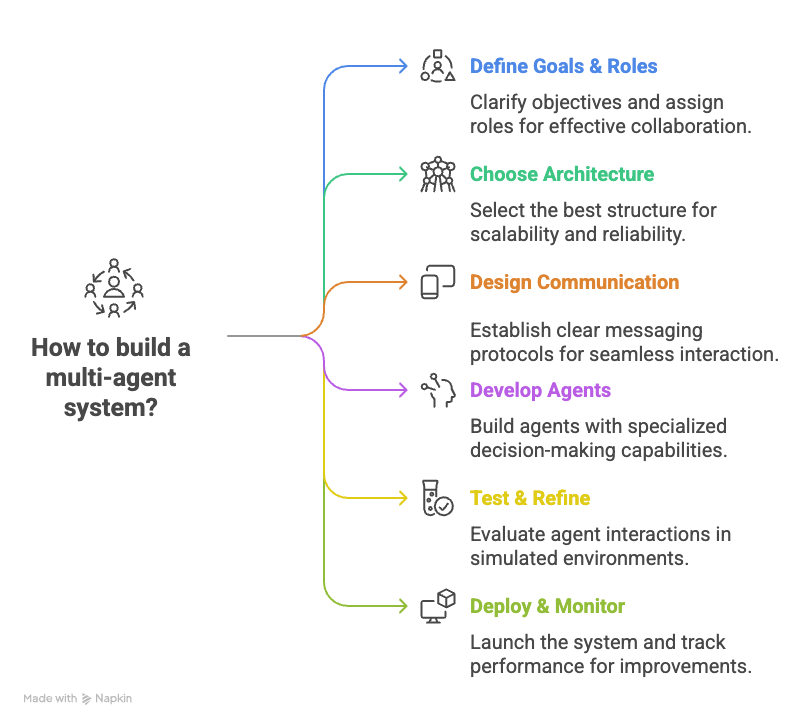
Build a Multi Agent System with Ease—and Let OneSky Lighten the Load
Creating a multi-agent system is about designing a collaborative ecosystem of specialized AI agents that work together to solve complex problems.
With the right approach, you can build a scalable, resilient, and efficient system.
Here are some key steps to get started:
How to Build Your Multi Agent System
1. Define Your Goals & Roles
Start by clarifying what you want your MAS to achieve—whether it’s optimizing supply chains, automating customer support, or managing industrial processes.
Then assign specific roles to each agent based on expertise.
2. Choose Your Architecture
Decide whether to go with a centralized, decentralized, hierarchical, or holonic structure.
Your choice depends on your system’s complexity, scalability needs, and reliability requirements.
3. Design Communication & Coordination Protocols
Implement clear messaging channels—whether direct peer-to-peer, via a supervisor, or through layered hierarchies. Robust communication ensures agents collaborate effectively without conflicts.
4. Develop and Configure Agents
Build agents with specialized decision-making, learning, and reasoning capabilities.
Focus on enabling flexibility and adaptability for real-world environments.
5. Test and Refine
Use simulated environments to evaluate how agents interact under different scenarios.
Regular tuning helps prevent unpredictable behaviors and optimizes performance.
6. Deploy and Monitor
Launch your MAS into production, and set up monitoring tools for ongoing performance evaluation.
Continuous feedback allows iterative improvements and adapts to changing demands.
Making MAS Deployment Hassle-Free with OneSky
Building a complex MAS requires technical expertise, time, and resources.
But here’s the good news: you don’t have to do it alone.

With solutions like OneSky Localization Agent, you get a streamlined, ready-made platform that handles key operational workflows—like localization—so you can focus on designing your system’s architecture and strategy.
By automating routine tasks and simplifying integration, OneSky lets you develop and scale your multi-agent ecosystem with greater ease, confidence, and security.
Ready to take your automation to the next level?
Let OneSky help make it smooth, scalable, and hassle-free. Start your free trial today!

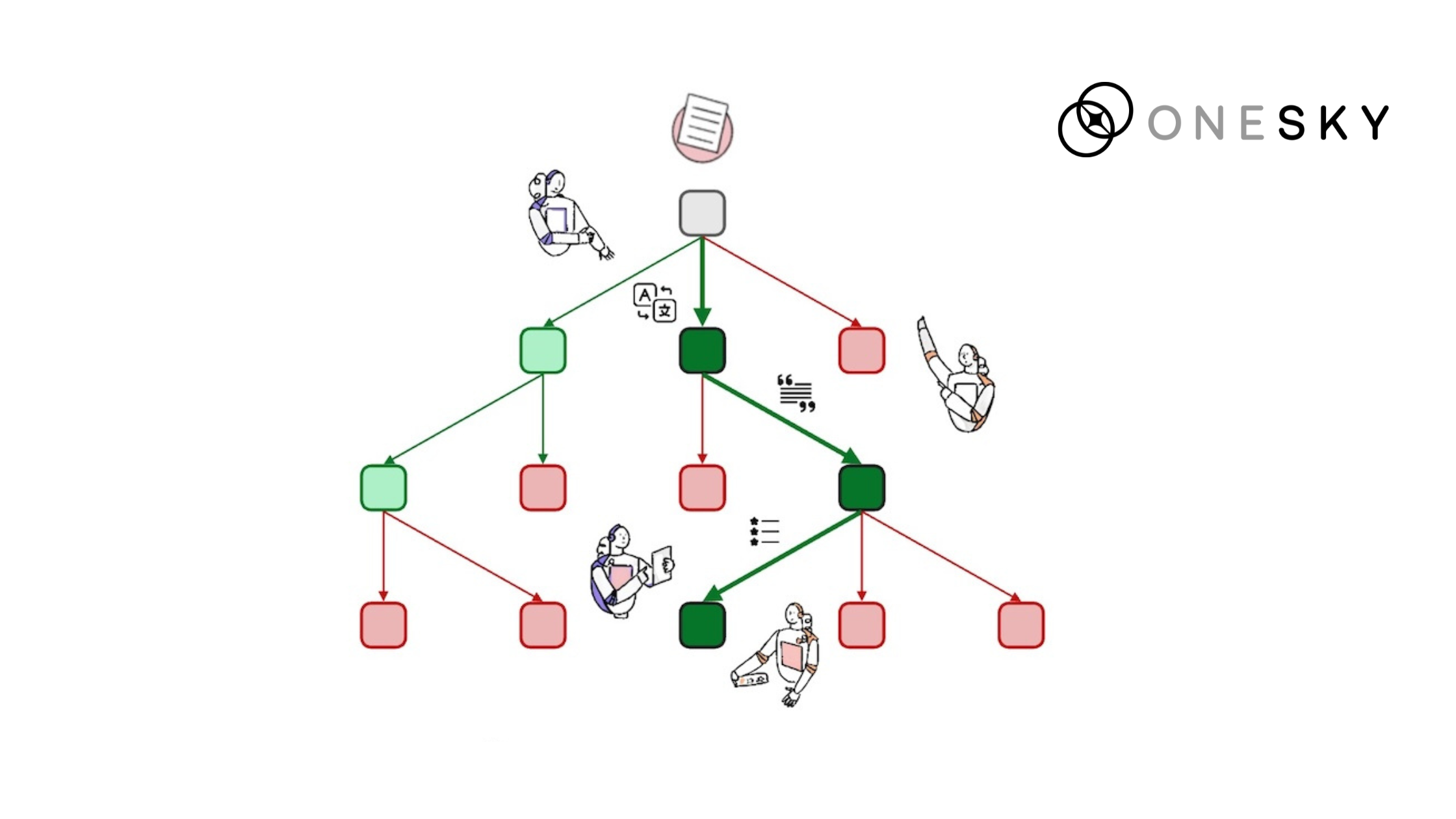
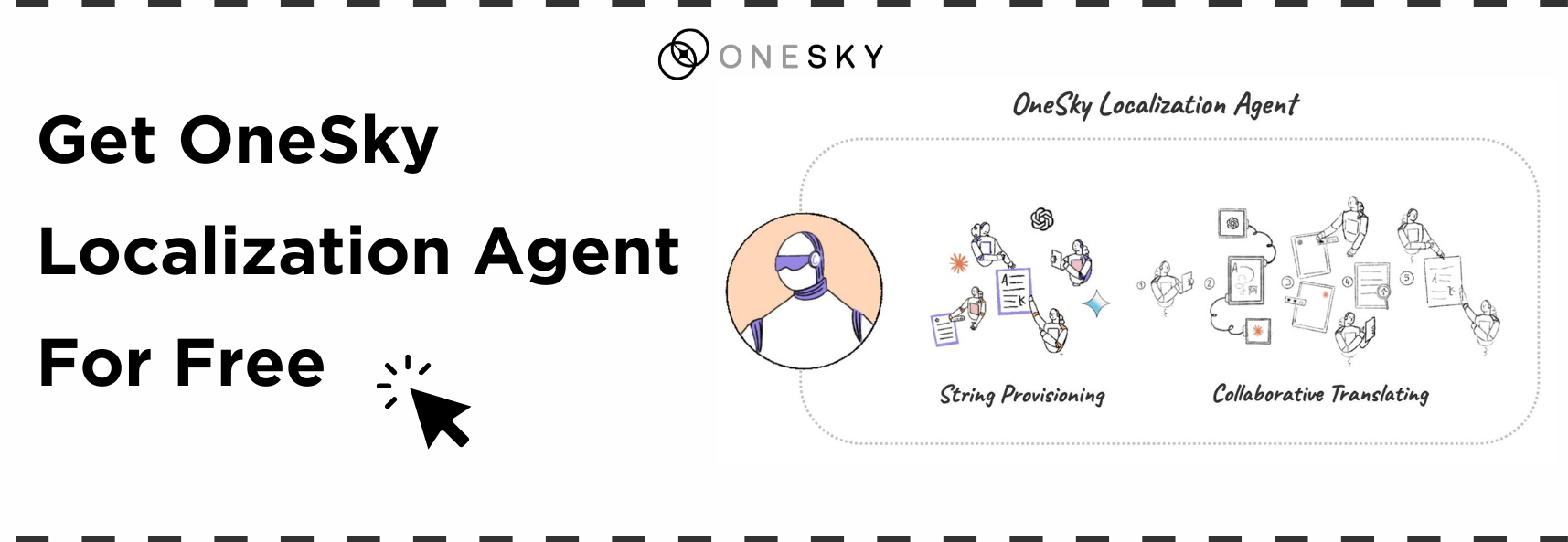
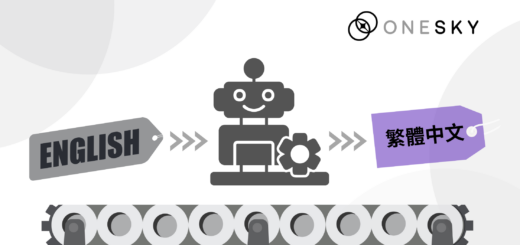
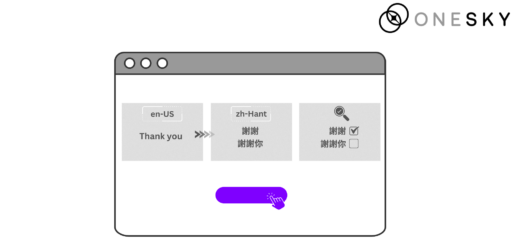
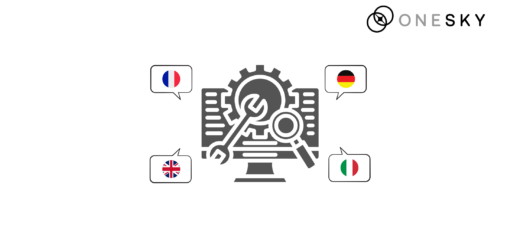
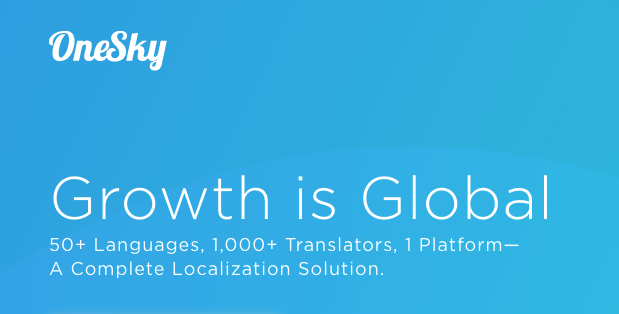

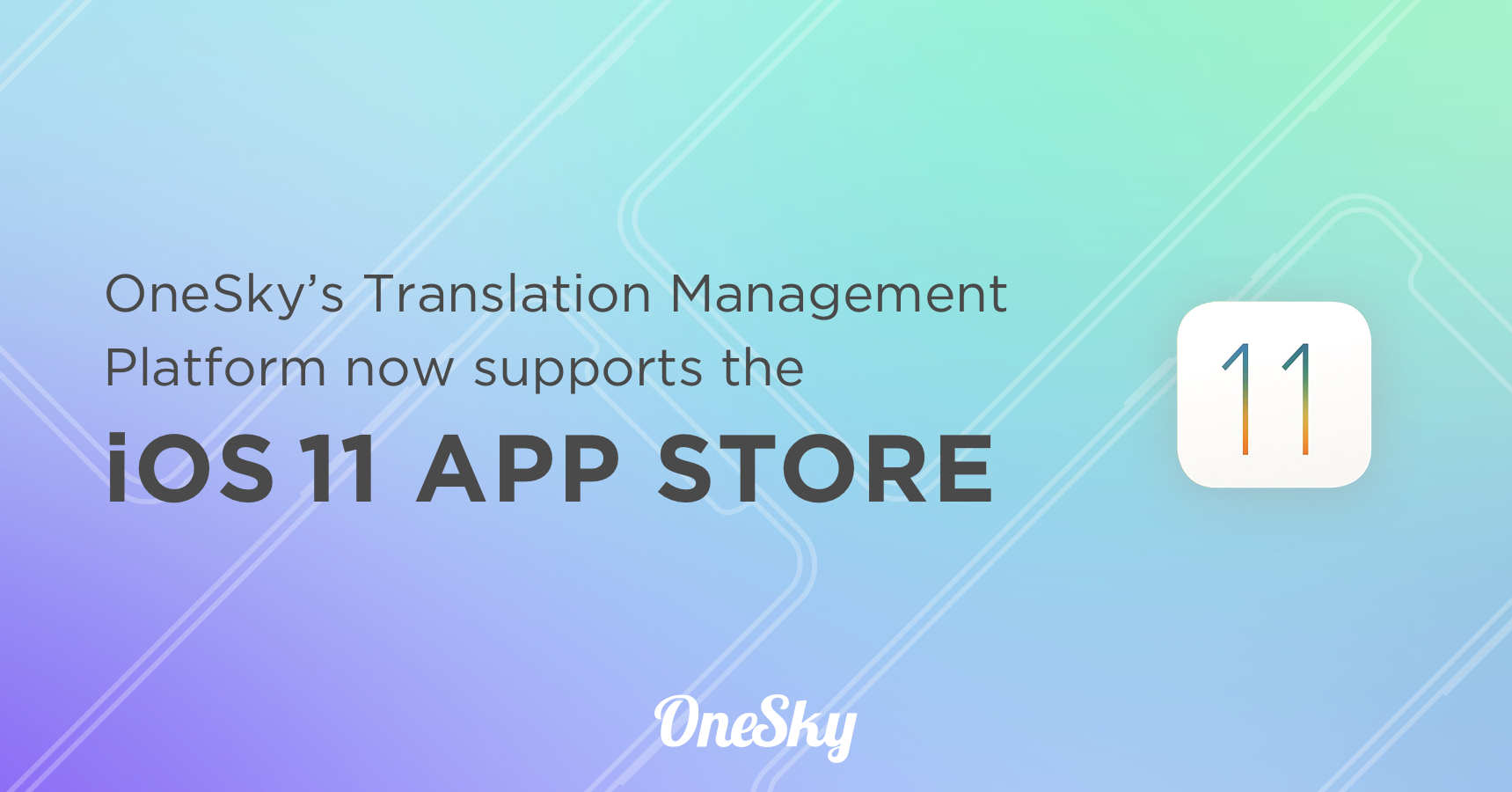
 Written by
Written by 

